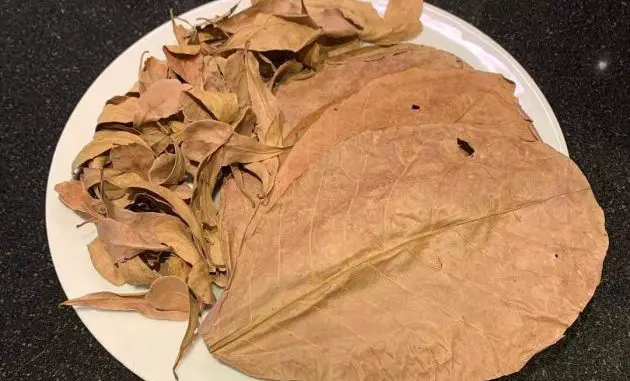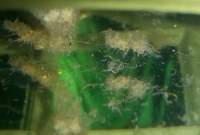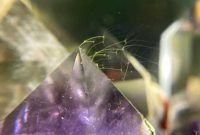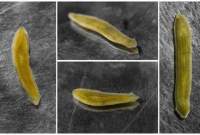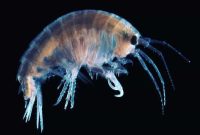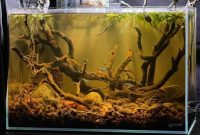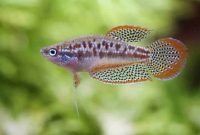The Best Leaf Litter For Dark Water Aquarium – When you describe a blackwater tank, the water is brown, the bottom side tends to be filled with scattered leaf litter, driftwoods, roots, and stones are more used for the hardscape, planting with a little few aquarium plants or nothing. And inhabitant by the fish species that only can survive in acidic water.
Blackwater streams in the wild are created by falling leaves drop off to the water constantly and tint it to brown color, sometimes almost black. This environment is usually found in tributaries or rivers that flowing through dense forests and vegetation.
One of the other substances which cause this transformation is called tannin. It can be found in various quantities in most dried leaves. This compound is also weak acid and can lower the pH level of the water.
Tannins are beneficial in soft water because the buffer capacity of hard water can efficiently neutralize its acidity. When you choose the suitable dry leaves for your fish and aquarium, you could reach two goals: excellent colored water and low pH level without adding chemicals.
Some dry leaves also have other benefits for the fish species. It is knowing contains organic substances that stop bacterial and fungal problems without using the medications.
Most fish farmers and exporters from Asia use the catappa (ketapang or Indian almond) leaf to reduce stress and heal fish’s illnesses.
Below is the list of famous leaf litter from the different countries which often used by the aquarist for their black water aquarium:
The Best Leaf Litter For Dark Water Aquarium
Alder Cones
There are some aquarists that misunderstanding alder cones are pine cones. These cones are catkins of Alnus glutinosa (black alder trees). It is native to Europe, Northern Africa, and Southwest Asia. Alder trees also have been introduced to Canada and the US.
Common names of the alder cones are black alder, European alder, European black alder, and common alder. Its appearance seems like a tiny cone, and it will look more brown colored when autumn.
The alder trees produce a flower-like cone that bore female and male parts. When the female flowers are pollinated, the flower becomes brown and hardens into the “cones” that keep the seeds.
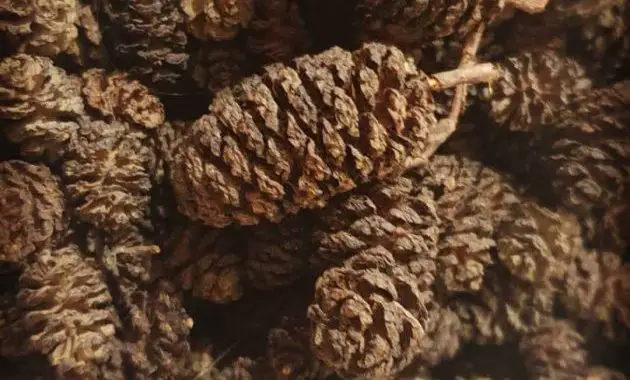
Alder cones are rich with tannins, phenol, and other substances which work as anti-bacterial, anti-fungal, anti-parasitic and can slightly lower the pH level.
This leaf litter for aquariums has more benefits based on the types of aquarium, including creating blackwater effects on south American biotope aquariums and stimulating the fish such as angelfish, discus, dwarf cichlids, and betta to spawning, providing extra live foods, and boost health level for freshwater shrimps.
Using alder cones in the aquarium is simple. You can add directly clean alder cones into the aquarium. The first time introduced into the tank, it will tend to float on the surface and need more time until sinking to the bottom of the tank. Soaking in hot water for around 30 minutes can speed up this process.
Besides, if you want to make the alder cones invisible in the aquarium, you can boil the alder cones to makes the extract. Or, If you use the canister filter, you can put it there, and it still releases the tannins.
How many alder cones per gallon? Most of the aquarists add around 5 cones per 10 gallons (1 piece for 2 gallons).
Read Also: COMPLETE Blackwater Fish Tank Setup Guide
Indian Almond Leaves A.k.a. Catappa Leaf
Another material for creating dark water effects is Indian almond leaves (Catappa leaves) from Terminalia catappa trees. These trees originate from Asia, the Pacific, Madagascar, and Australia. The Other common names of these leadwood tree families are Malabar almond, sea almond, beach almond, tropical almond, country almond, and false Kamani.
The trees can grow up to 35 m (115 ft) tall with an upright and symmetrical crown. Its branches are horizontal. Catappa trees have large leaves between 15-25 cm (5.9-9.8 inches) long and 10-14 cm (3.9-5.5 inches) in broad with ovoid shapes, leathery, and have glossy dark green color.
These trees are usually called Indian Almond because it has seeds fruit with a taste almost similar to almond.
Malabar almond trees shed the leaves twice a year. Before falling off from the branches, the leaves will turn orange/purple in color. Harvesting this leaf litter is simply by picking it up from the ground and then ready for the aquarium. Washing the leaves is necessary before put to the tank.
The Leaves’ quality is determined by some factors including, lighting, substrates, and processing. So that’s why you should buy the Catappa leaves from reputable sellers (Click The Red Link To Buying Indian Almond Leaves).
There are some benefits from using this leaf litter for your aquarium based on the types of conditions, and the list is below:
- Increase the water quality of your fish tank (Significantly in Betta, Discus, Gouramis, Tetra, Angelfish, Barbs, Platies, Killifish, Rasboras, Cory catfish)
- Works as a natural treatment for fish skin problems
- Become a spawning material for your fish
- An extra food source and shelter media for the fish fry
- A favorite food resource for some freshwater shrimps
How to use the Indian almond leaves in the aquarium? Like the alder cones, you drop it directly into your tank or place it on the filter if you use a canister filter. The second is boiling it to get the blackwater extract.
How many leaves that I use for gallon water? You start with one medium-large leaf for 10 gallons of water. You can replace the leaves once a month or whenever you want. Letting off the leaves to completely decaying is not a problem and remove it when only leftover veins. It generally needs up to two months.
Read Also: Asian Popular Freshwater Aquarium Fish Types That Originally Live In Blackwater
Oak Leaves
There are three varieties of oak leaves types that are usually in blackwater aquariums, including Sessile oak (Quercus patrea), Turkey oak/Austrian oak (Quercus cerris), and European oak/pedunculate oak (Quercus robur).
Their leaves’ sizes and shapes are different, but all varieties contain relatively high tannin, making them one of the best natural pH decreasers. They are also excellent for changing water tint to brown color.
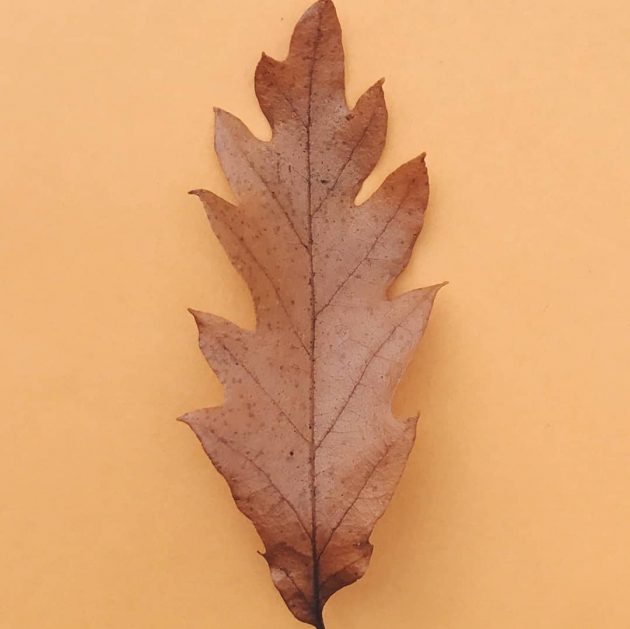
Buy Dried Oak Leaves Only On Amazon
Using Oak leaves are the same as the leaf litter material above, and they also have benefits for the aquarium, very similar to alder cones and catappa leaf.
You will require at least two medium sizes of Oakleaf for 50 litter water. Oak and catappa leave usually sink the water between 1-2 days, and it can be used for about 2 months until fully decomposing. Replace the leaves once a month is recommended.
Read Also: South American Fish For Aquarium That Native To Blackwater
Beech Leaves
European beech or common beech is a deciduous tree with the scientific name “Fagus sylvatica.” The trees can grow to reach up to 160 ft (50 m) tall with a diameter of around 9.8 ft (3 m). These trees can be found throughout southern Sweden, northern Sicily, southern England, northern Portugal, France, central Spain, and northwest Turkey.
Beech leaves are relatively thin and small, with 5-10 cm in length, broad between 3-7 cm, and veins about 6-7 pieces on each side of the leaf. Due to its small size, beech leaf normally only gives a small yellowish effect on the water and reduces a small amount of pH level.
This leaf litter is very compatible with nano or shrimp aquariums that contain species requiring a pH level almost neutral, such as Neocaridina and Cherry shrimps. (Buy Dried Beech Leaves Only On eBay)
You can add 1-2 medium leaves for 20-liter water. The leaves can be leftover until they are completely decomposed. The decaying process of the beech leaves is faster than oak, only need a couple of weeks. You can replace the leaf after 1-2 weeks or optional.
Read Also: 3 Best Tropical African Fish For Blackwater Aquarium
Hornbeam
Hornbeam leaves are produced by Carpinus betulus (European or common hornbeam trees) is another leaf litter commonly found in the black water aquarium hobbyists. The hornbeam trees are native to southern, eastern, and central Europe and western Asia.
It trees commonly reach up to 15-25 in length with small leaves between 4-9 cm. However, its size is smaller than the catappa leaf, and it has an acidifying effect very similar to that of leaves.
You will require more hornbeam leaf to reach the same effect, but it can reduce pH quickly. So, be careful when using it, do not let make your pets be stressed.
A better method is to bring down a couple of leaves depending on your aquarium size every day until achieving the desired effect.
Read Also: Are Axolotls Good Pets For You? It’s A Complete Guide Of Keeping, Feeding, Behavior, Characteristics
Hazel
A hazel leaf litter is a good choice for your aquarium if you want the water to have smooth brown coloring and still have the impact of decreasing the pH level. These leaves are produced by Corylus avellana (common hazel trees), that often found in Asia and Europe. (Buy Dried Hazel Leaves Only On eBay)
The hazel tree is typically a shrub that grows up to 3-15 meters with slightly larger leaves around 6-12 cm. This leaf litter is rigid and thick, making it frequently avoided by the shrimp or other algae eater species.
Read Also: 10 Good Reason Why You Should Have An Aquarium Fish At Your Home
Sycamore
The sycamore leaves are larger than hazel. It produces by Acer pseudoplatanus (sycamore or sycamore maple trees). The trees can reach up to about 35 meters tall with leaves large between 10-25 cm.
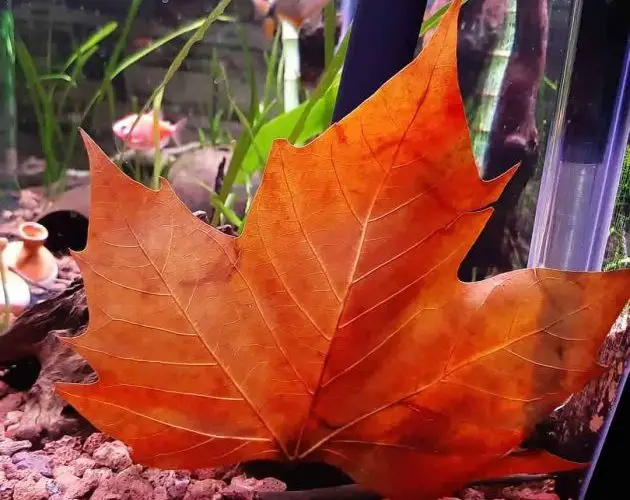
Sycamore leaf litter has a strong and fast coloring effect on the water. The decomposing process is quite quick, and the remaining semi-transparent leaves blade becomes a tasty extra food for your aquarium snails and shrimps.
Unfortunately, the pH decreasing capability is shorter than Indian almond leaves. When the beginning pH level is a sudden drop, after that, it will increase again.
Japanese Maple
Acer palmatum, also popularly called Japanese maple or smooth Japanese maple or palmate maple is a woody plant species originating from Japan, China, Korea, Southeast Russia, and eastern Mongolia.
Japanese maple trees can reach a height up to 6-10 meters. Its leaves usually reach up to 4-12 cm wide and long, with the palmately lobed arranged from five, seven, or nine acutely pointed lobes. (Collect Your Japanese Maple Trees Only On Amazon)
This Japanese leaf litter can drop the pH level and color the water, but it is broken down faster than the Oak leaves in the tank. So you will be often put and change it when using this material to create a tea-colored water effect for your aquarium.

